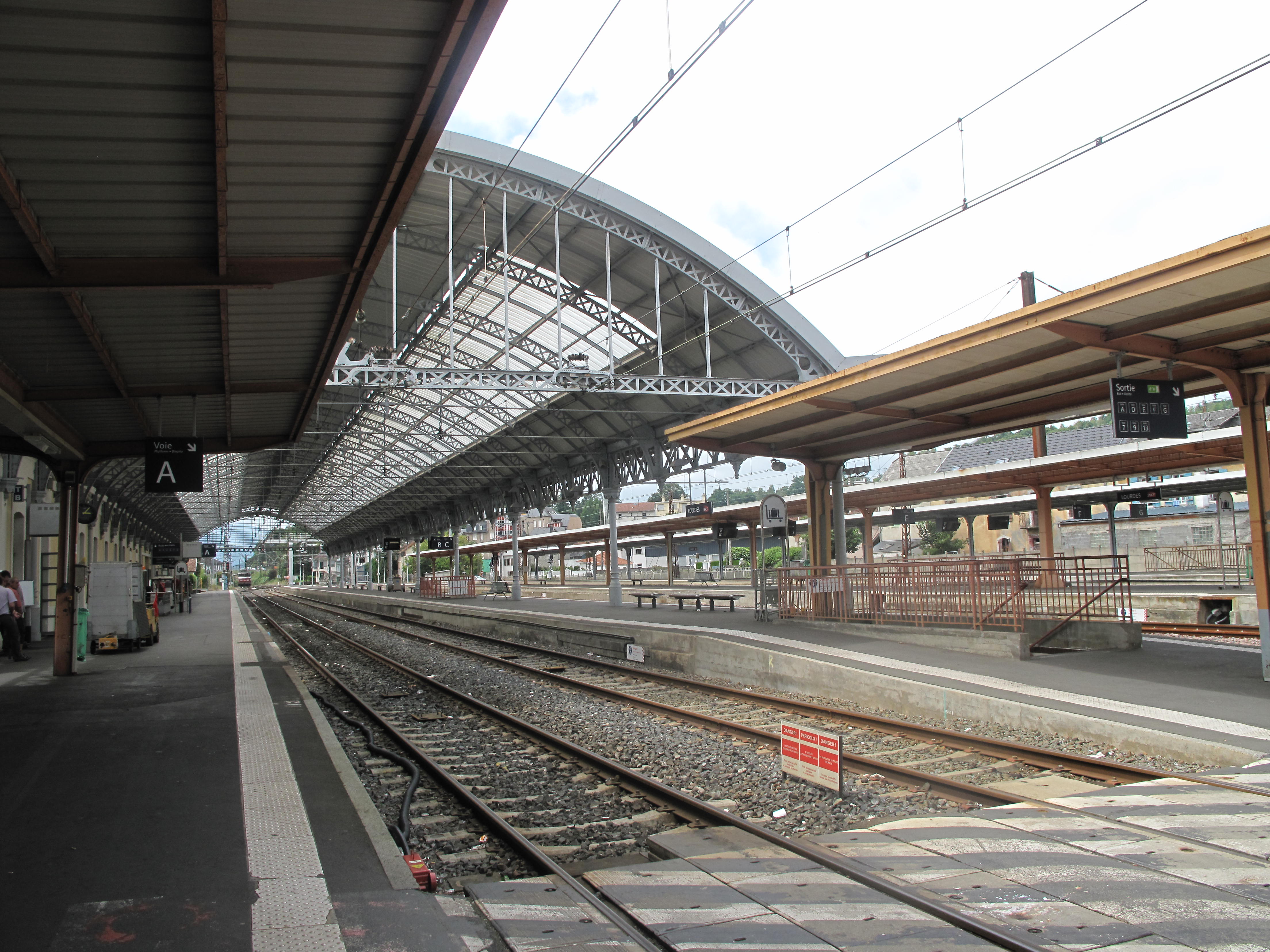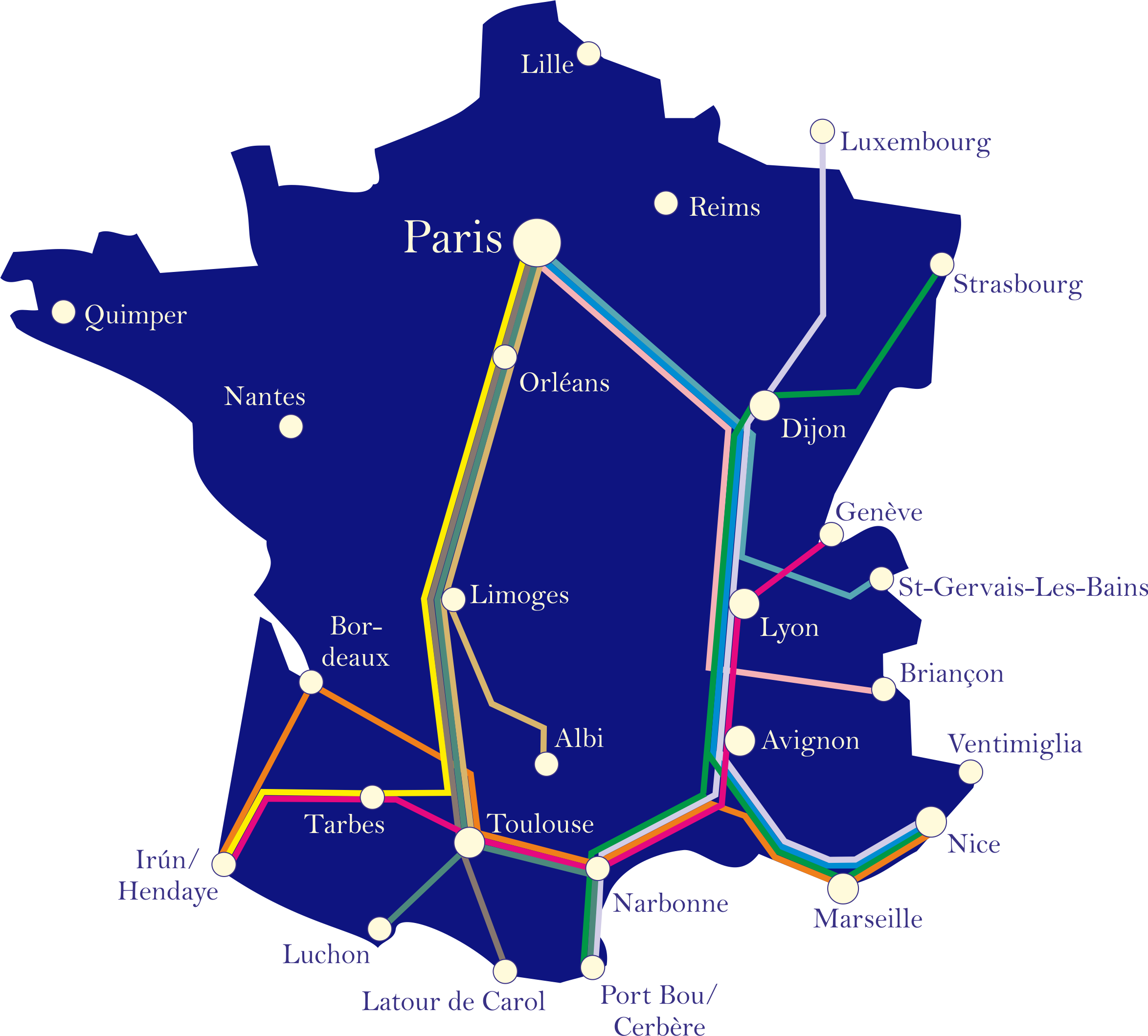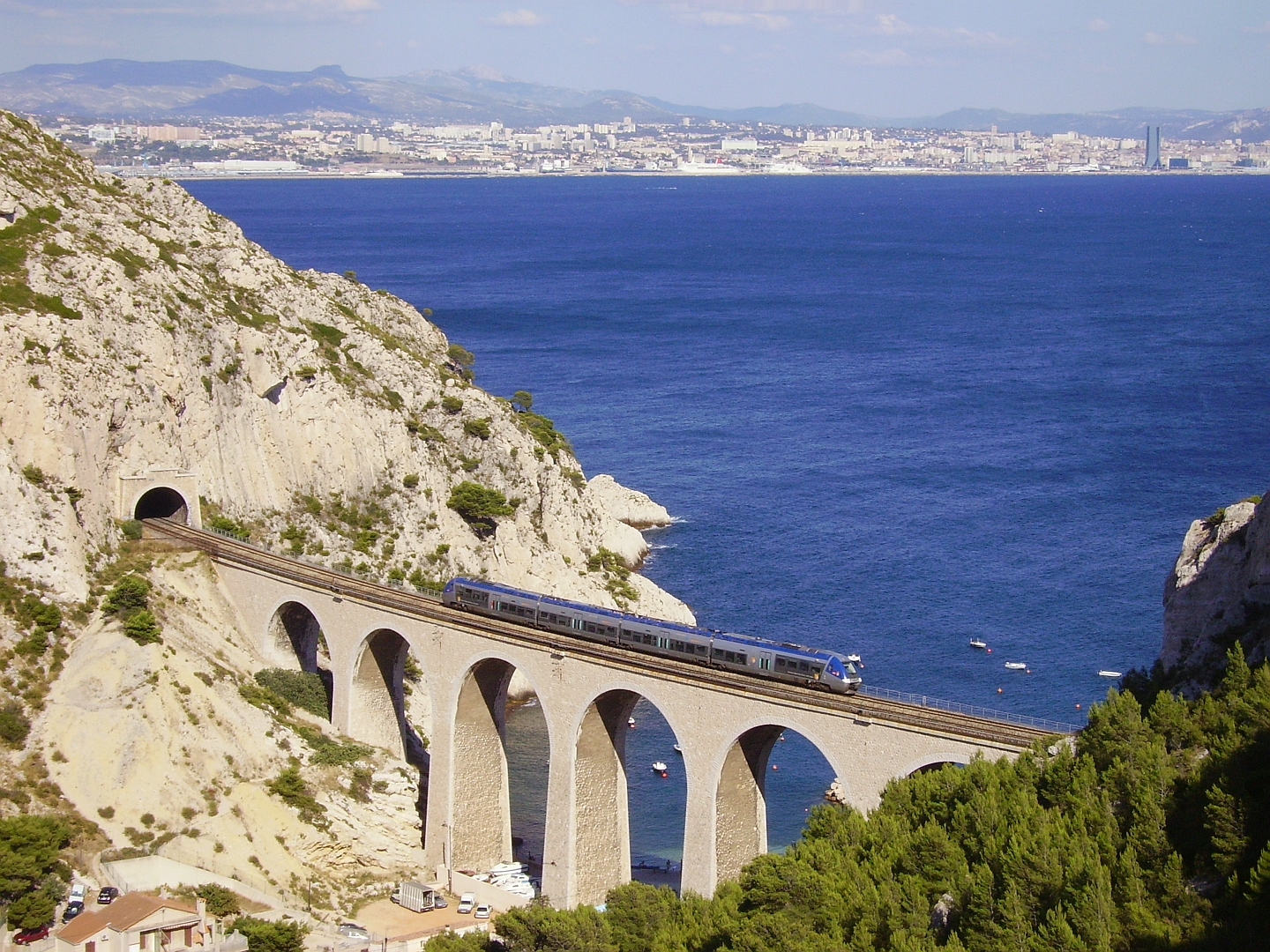|
Lourdes Station
The gare de Lourdes is a railway station in Lourdes, Occitanie, France. The station is on the Toulouse–Bayonne railway line. The station is served by TGV (high speed trains), Intercités de Nuit (night trains), Intercités (long distance) and TER (local) services operated by the SNCF. The station is important for those coming to Lourdes on Catholic pilgrimages, with extra trains running to Lourdes at certain times. Train services The following services currently call at Lourdes: *TGV services Paris - Saint-Pierre-des-Corps - Bordeaux - Dax - Pau - Tarbes *intercity services (''Intercités'') Hendaye–Bayonne–Pau–Tarbes–Toulouse *local service (TER Nouvelle-Aquitaine) Bodreaux-Dax-Pau–Tarbes *local service (TER Nouvelle-Aquitaine) Bayonne–Pau–Tarbes *local service (TER Occitanie) Toulouse–Saint-Gaudens–Tarbes–Pau References Railway stations in Hautes-Pyrénées Railway Station Rail transport (also known as train transport) is a means of transport ... [...More Info...] [...Related Items...] OR: [Wikipedia] [Google] [Baidu] |
Lourdes
Lourdes (, also , ; oc, Lorda ) is a market town situated in the Pyrenees. It is part of the Hautes-Pyrénées department in the Occitanie region in southwestern France. Prior to the mid-19th century, the town was best known for the Château fort de Lourdes, a fortified castle that rises up from a rocky escarpment at its center. In 1858 Lourdes rose to prominence in France and abroad due to the Marian apparitions claimed to have been seen by the peasant girl Bernadette Soubirous, who was later canonized. Shortly thereafter the city with the Sanctuary of Our Lady of Lourdes became one of the world's most important sites of pilgrimage and religious tourism. History Antiquity The current municipal area of Lourdes was inhabited in prehistoric times. In Roman times it had to be, since the first century BC, an oppidum hill where today stands the fortress, as is testified by the numerous finds that came to light in the second half of the nineteenth century (remains of walls, fr ... [...More Info...] [...Related Items...] OR: [Wikipedia] [Google] [Baidu] |
Toulouse–Bayonne Railway
The railway from Toulouse to Bayonne is an important French 319-kilometre long railway line, that connects the southern city Toulouse to the southwestern town Bayonne, running along the foothills of the Pyrenees. The railway was opened in several stages between 1861 and 1867. Route The Toulouse–Bayonne railway leaves the Toulouse-Matabiau station in southern direction. It crosses the river Garonne south of Toulouse city centre, and follows the Garonne left bank upstream in southwestern direction. It crosses the Garonne twice near Saint-Martory, and turns west, still on the left Garonne bank. It crosses the Garonne again at Saint-Gaudens and at Montréjeau, where it leaves the Garonne valley. Beyond Lannemezan the railway turns northwest towards Tarbes, where it turns southwest towards Lourdes. At Lourdes it turns west again and starts following the Gave de Pau downstream, on its right bank. At Saint-Pé-de-Bigorre the river and the railway turn northwest towards Pau and Puyo� ... [...More Info...] [...Related Items...] OR: [Wikipedia] [Google] [Baidu] |
Réseau Ferré De France
Réseau ferré de France (RFF, french: French Rail Network) was a French company which owned and maintained the France, French national railway network from 1997 to 2014. The company was formed with the rail assets of SNCF in 1997. Afterwards, the trains were operated by the SNCF, the national railway company, but due to EU Directive 91/440, European Union Directive 91/440, the Government of France was required to separate train operations from the railway infrastructure. On 1 January 2015, RFF became ''SNCF Réseau'', the operational assets of SNCF became ''SNCF Mobilités'', and both groups were placed under the control of SNCF. Unlike other infrastructure managers, RFF did not provide maintenance services or rail traffic control operations, which were both done by SNCF Infra on RFF's behalf. Furthermore, SNCF retained the ownership of stations. In September 2013, RFF had over €32 billion of debt. Overview The RFF was constituted with SNCF's infrastructure assets, and debts ... [...More Info...] [...Related Items...] OR: [Wikipedia] [Google] [Baidu] |
SNCF
The Société nationale des chemins de fer français (; abbreviated as SNCF ; French for "National society of French railroads") is France's national state-owned railway company. Founded in 1938, it operates the country's national rail traffic along with Monaco, including the TGV, on France's high-speed rail network. Its functions include operation of railway services for passengers and freight (through its subsidiaries SNCF Voyageurs and Rail Logistics Europe), as well as maintenance and signalling of rail infrastructure (SNCF Réseau). The railway network consists of about of route, of which are high-speed lines and electrified. About 14,000 trains are operated daily. In 2010 the SNCF was ranked 22nd in France and 214th globally on the Fortune Global 500 list. It is the main business of the SNCF Group, which in 2020 had €30 billion of sales in 120 countries. The SNCF Group employs more than 275,000 employees in France and around the world. Since July 2013, the SNCF Grou ... [...More Info...] [...Related Items...] OR: [Wikipedia] [Google] [Baidu] |
Occitania (administrative Region)
Occitania ( ; french: Occitanie ; oc, Occitània ; ca, Occitània ) is the southernmost administrative region of metropolitan France excluding Corsica, created on 1 January 2016 from the former regions of Languedoc-Roussillon and Midi-Pyrénées. The Council of State approved Occitania as the new name of the region on 28 September 2016, coming into effect on 30 September 2016. The modern administrative region is named after the larger cultural and historical region of Occitania, which corresponds with the southern third of France. The region of Occitania as it is today covers a territory similar to that ruled by the Counts of Toulouse in the 12th and 13th centuries. The banner of arms of the Counts of Toulouse, known colloquially as the Occitan cross, is used by the modern region and is also a popular cultural symbol. In 2015, Occitania had a population of 5,839,867. Toponymy Enacted in 2014, the territorial reform of French regions had been subject to debate for many years. ... [...More Info...] [...Related Items...] OR: [Wikipedia] [Google] [Baidu] |
Intercités De Nuit
Intercités de Nuit is a brand name used by France’s national railway company, SNCF, to denote overnight passenger rail services in France. It was known as ''Corail Lunéa'' before 2009 and as ''Lunéa'' from 2010 to 2012. Between 2013 and 2017, most services were cancelled due to budget cuts. Only four routes, from Paris to Briançon, Albi, Latour de Carol and Nice, were kept.SNCF Intercités, Lignes de nuit retrieved 16 November 2017 The brand has since been reintegrated into the main network. Network in 2022 As of 2022, the Intercités de Nuit network consisted of the following lines:[...More Info...] [...Related Items...] OR: [Wikipedia] [Google] [Baidu] |
Intercités
Intercités (before September 2009: ''Corail Intercités'') is a brand name used by France’s national railway company, SNCF, to denote non high speed services on the 'classic' network in France. SNCF established the Intercités brand in January 2006 to capture the remaining, mainly medium distance network of Corail (train), Corail trains, so called because they use the air-conditioned fleet of 'Corail' coaches introduced by SNCF from 1975. Intercités covers all the important SNCF routes not served by the TGV network. Since December 2011, the Téoz (long distance trains with obligatory reservation) and Intercités de Nuit (overnight sleeper train) brands have been re-integrated and the Intercités brand now covers all non-high speed SNCF national-network passenger services. In October 2012, the French government announced increased funding for Intercités services, as part of a new transport strategy. Network The Intercités network consists of the following lines as of Januar ... [...More Info...] [...Related Items...] OR: [Wikipedia] [Google] [Baidu] |
Transport Express Régional
Transport express régional (, usually shortened to TER) is the brand name used by the SNCF, the French national railway company, to denote rail service run by the regional councils of France, specifically their organised transport authorities. The network serves French regions; Île-de-France (Transilien) and Corsica ( CFC) have their own specific transport systems. Every day, over 800,000 passengers are carried on 5,700 TER-branded trains.Le TER en 2030 ''SNCF'' Retrieved 2011-02-15 TER is part of , a branch of the SNCF dealing with urban and regional passenger rail, which also includes |
Gare De Lourdes
The gare de Lourdes is a railway station in Lourdes, Occitanie, France. The station is on the Toulouse–Bayonne railway line. The station is served by TGV (high speed trains), Intercités de Nuit (night trains), Intercités (long distance) and TER (local) services operated by the SNCF. The station is important for those coming to Lourdes on Catholic pilgrimages, with extra trains running to Lourdes at certain times. Train services The following services currently call at Lourdes: *TGV services Paris - Saint-Pierre-des-Corps - Bordeaux - Dax - Pau - Tarbes *intercity services (''Intercités'') Hendaye–Bayonne–Pau–Tarbes–Toulouse *local service (TER Nouvelle-Aquitaine) Bodreaux-Dax-Pau–Tarbes *local service (TER Nouvelle-Aquitaine) Bayonne–Pau–Tarbes *local service (TER Occitanie) Toulouse–Saint-Gaudens–Tarbes–Pau References Railway stations in Hautes-Pyrénées Railway Station Rail transport (also known as train transport) is a means of transport th ... [...More Info...] [...Related Items...] OR: [Wikipedia] [Google] [Baidu] |
Railway Stations In Hautes-Pyrénées
Rail transport (also known as train transport) is a means of transport that transfers passengers and goods on wheeled vehicles running on rails, which are incorporated in tracks. In contrast to road transport, where the vehicles run on a prepared flat surface, rail vehicles (rolling stock) are directionally guided by the tracks on which they run. Tracks usually consist of steel rails, installed on sleepers (ties) set in ballast, on which the rolling stock, usually fitted with metal wheels, moves. Other variations are also possible, such as "slab track", in which the rails are fastened to a concrete foundation resting on a prepared subsurface. Rolling stock in a rail transport system generally encounters lower frictional resistance than rubber-tyred road vehicles, so passenger and freight cars (carriages and wagons) can be coupled into longer trains. The operation is carried out by a railway company, providing transport between train stations or freight customer faciliti ... [...More Info...] [...Related Items...] OR: [Wikipedia] [Google] [Baidu] |




